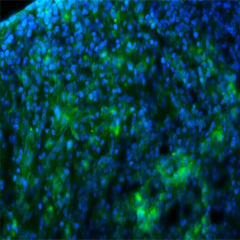


Description
in vivo DNA RNA Advanced Transfection Reagent can be injected intravenously or by local tissue injection in vivo. Further more, total injection volume is very small, dense tissue can be transfected by microinjection and the time of circulation in vivo is long. Both DNA, siRNA and co-transfection can becarried out.
General Considerations
1> DNA quality requirements
Concentration: 300 ng/ul - 2 μg/ul;
Solution: dissolved in ddH2O or ultra-pure wate;
Endotoxin: removed
2> RNA quality requirements
Concentration: 20 μM, 40 μM, 60 μM, 80 μM
General Protocol for in vivo Transfection
1> Complex preparation: Nucleic acid was directly mixed with transfection reagent according to 1:1 relationship. Then use a pipette to blow up 10-15 times to mix. After incubating at room temperature for 10-15 minutes, complex would be prepared. During the procedure, no liquid residue was ensured on the wall of tube.
2> Intravenous injection or local tissue injection of prepared complex can be proceeded with a syringe or microinjection needle.
3> 3 or 5 days after injection, efficiency of transfection would reach the peak, and expression of target gene could be detected then.
Important Guidelines
1> The ratio of DNA (μg) or 20 μM siRNA (μl) to transfection reagent (μl) should be 1:1.
2> The volume of siRNA used in above table is specific for siRNA of 20 μM. If the concentration of siRNA is 40 μM, the volume of siRNA in above table should be halved. If the concentration of siRNA is 80 μ M, the volume of siRNA in above table should be divided by 4, and so on.
3> When local tissue injection is performed, the amount of the complex should be 5-10 μl/cm2.
4> In co-transfection experiment, the total amount of nucleic acid in above table remains the same, the proportion of various nucleic acids could be adjusted according to experimental requirements, then nucleic acids can be mixed with transfection reagent sufficiently.
5> In the specific experimental operation, the dosage of nucleic acid and transfection reagent can be adjusted according to the "maximum injection volume" in the table above.


